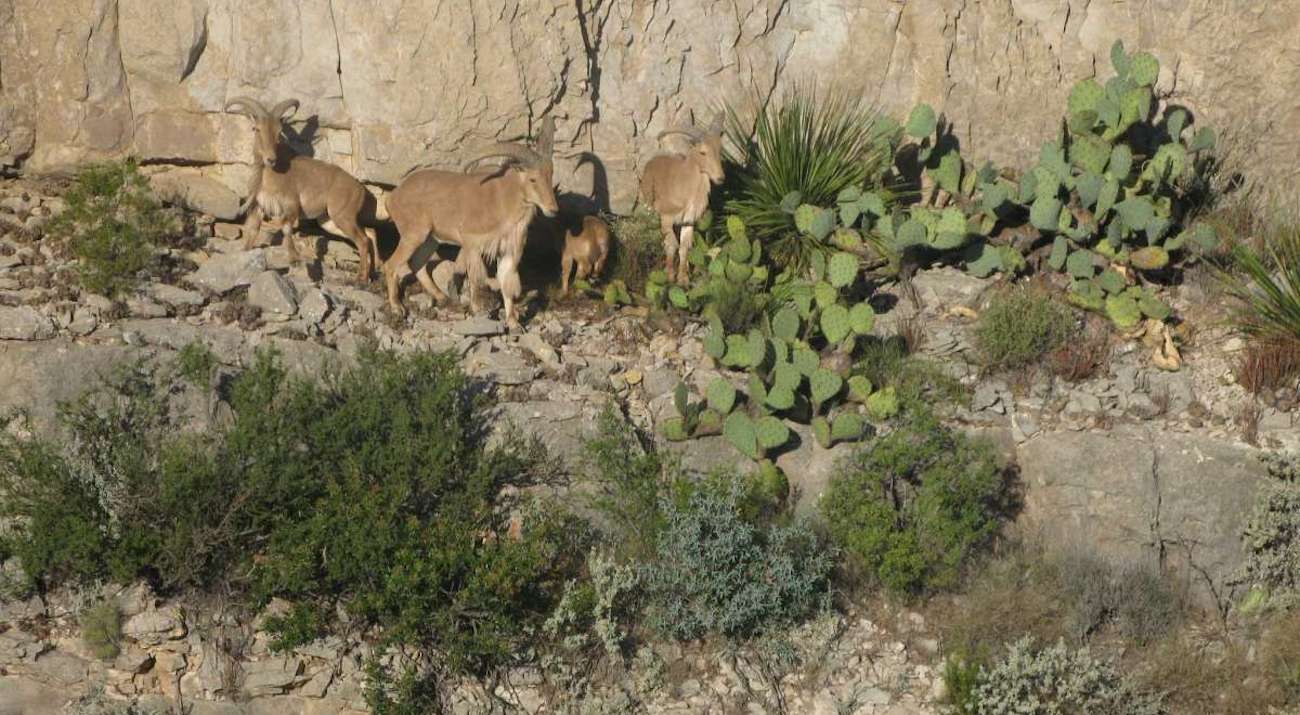Aerial Shooting in Big Bend Park Spooks and Angers Hikers

On Texas’ public lands, helicopters are routinely used by bighorn sheep managers to kill ‘exotic’ animals and predators – often while counting game. This terrifies wildlife. Years of doing this has taught sheep, deer, elk and pronghorn to associate helicopters with mortal danger. This places extreme stress on animals – especially fawns and lambs, and limits the usefulness of helicopter game counting because – as we observe at Circle Ranch – animals increasingly hide from them.
Shooting wild animals with automatic weapons from helicopters – then leaving them to rot – violates two key wildlife ethics: ‘Fair Chase’ which gives hunted animals a chance to escape, and the duty to not waste wild game that is killed. Virtually all wildlife managers say they support these concepts. Much of the public finds this ‘management’ repulsive as well as personally threatening. Notwithstanding their good intentions, those who do these things paint a bullseye on sports hunting, gun rights and bighorn restoration efforts.
Since about 2008, it has been written policy to remove many species including cattle, elk, burros, longhorn, aoudad and at times predators from public lands to help desert bighorn introductions. Big Wildlife takes it as proven that bighorn will thrive best where most other animals – so-called ‘competition’ – are removed. But, according to the article, only a few of 200 sheep released in the park have survived. Agency eradications have backfired and across far-West Texas sheep actually declined this year – an alarming trend that mirrors other iconic wild species’. As the article says, managers plan to continue rather than rethink their ‘control activities’. There is a better, cheaper and more effective alternative: here is how we successfully increase sheep numbers at Circle Ranch.
NOTE: this article is from the San Antonio Express News (ExpressNews.com) and was published on September 21, 2018. It was written by John MacCormack
When the gunfire erupted recently at Big Bend Ranch State Park, frequent visitor Joe Flinn and his girlfriend were hiking up the trail toward Rancherias Falls.
“The trailhead is near the border, so when we heard the shots, we thought, ‘Now, we can’t turn around. It could be cartel activity,’” he recalled.
Instead, Flinn and Cassidy Bayles tried to move away from the shooting and hiked several miles deeper into the park, the largest in the state system. But the shooting followed them.
“Then we started seeing the helicopter. They hovered right above us. It was a shooting spree, so we started taking cover,” said Flinn, who’s from Magnolia.
Video and photos taken on a smartphone show the unmarked purple helicopter roughly overhead. Neither it nor the men shooting from it were identifiable, and for the next four hours, whenever it appeared, Flinn and Bayles laid low, in fear for their lives, he said.
They eventually concluded that the men were shooting wildlife in the canyons.
The park, which sprawls across 315,000 acres of rugged Chihuahuan Desert, is home to mountain lions, mule deer, wild burros and bighorn sheep, which were reintroduced about a decade ago.
Unknown to the hikers — and to some park rangers — state wildlife officials had chosen Aug. 18 to kill aoudads, an exotic species from North Africa also known as Barbary sheep, which competes with the bighorns.
When Flinn and Bayles obtained a day permit to use the park from the Barton Warnock Visitor Center in Lajitas, no mention was made of any unusual activity or any areas that were off-limits to visitors.
When the rattled couple returned to the Warnock Center the next day, the ranger on duty was baffled by their account.
“Not having any information that Texas Parks and Wildlife was doing anything, my gut reaction was that it was a private hunt that had gone way off course,” said Buckner Cooke, a seasonal ranger.
“The Flinns showed me the video of the helicopter. It had no markings, other than a serial number. And the individuals inside were not wearing what I recognized as uniforms,” he said.
Later that day, Cooke learned that the wildlife division of the Texas Parks and Wildlife Department had come to the park to do a “survey” that, he said, “apparently included shooting aoudad.”
Cooke apologized to Flinn and Bayles and explained what had happened. Flinn was not appeased and recently filed a five-page complaint with the department, saying “lives were recklessly endangered,” laws were broken and “charges should be filed.”
“Plans need to be implemented to protect visitors so that they can hike in the park and not be worried about being shot dead or witness a four-hour wildlife slaughter,” it said.
Steve Lightfoot, a spokesman for Parks and Wildlife, disputed the claim that the survey was done without adequate notice.
“Wildlife (division) and state parks staff at the local, regional and state quarters level were aware of the annual survey operation, as well as the dates during which aerial flights and possible aoudad control activities would occur at the park,” he said.
